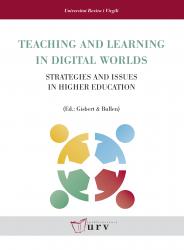Teaching and Learning in Digital Worlds: Strategies and Issues in Higher Education
Sinopsis
Many reports over the last few years have analysed the potential use of games, videogames, 3D environments and virtual reality for educational purposes. Numerous emerging technological devices have also appeared that will play important roles in the development of teaching and learning processes. In the context of these developments, learning rather than teaching becomes the main axis in the organisation of the educational process. This process has now gone beyond the analogue world and face-toface education to enter the digital world, where new learning environments are being produced with ever greater doses of realism. Teaching and Learning in Digital Worlds examines the teaching and learning process in 3D virtual environments from both the theoretical and practical points of view.
Read the ebook online · Google Books
***
TABLE OF CONTENTS
PROLOGUE, Tony Bates
INTRODUCTION, Mercè Gisbert and Mark Bullen
CHAPTER 1: 21st CENTURY EDUCATION: GENERIC COMPETENCES AND DIGITAL LEARNERS.
1.1 Digital Learners in Higher Education: Implications for teaching, learning & technology. Mark Bullen and Tannis Morgan
1.2 Design, development and evaluation of generic competencies. Eugenio Astigarraga
1.3 The Digital Competence. Joan González and Cinta Espuny
1.4 Teamwork and Self-management. Sofía Isus, Cristina Torrelles, Jordi Coiduras, F. Xavier Carreras, Jorgina Roure and Georgina París
1.5 Quality assurance in e-learning programs. Afsaneh Sharif CHAPTER
2: NEW STRATEGIES AND NEW TECHNOLOGICAL ENVIRONMENTS FOR UNIVERSITY EDUCATION.
2.1 Advanced technology environments to support the teaching/learning process in the university. Mercè Gisbert and José M. Cela-Ranilla
2.2 Cyborgs at the university: Gaming for educational purposes. Janaina Minelli de Oliveira, Eliana Gallardo and Annachiara del Prete
2.3 Lessons learned on simulation-based learning. Jens Siemon
2.4 Evaluating digital competence in simulation environments. Virgínia Larraz and Francesc Esteve
CHAPTER 3: 3D VIRTUAL ENVIRONMENTS IN EDUCATION.
3.1 Moving beyond learning: the potencial of immersive environments in education. Mar Camacho and Vanessa Esteve-González
3.2 Planning the learning of general competences using 3D virtual environments. Luis Marqués, Cinta Espuny and Noemí Rabassa
3.3 Making 3D objects in virtual learning environments. Vanessa Esteve-González, Byron Vaca and Nicolay Samaniego
3.4 Design of learning activities for 3D technological environments. Josep Holgado and Ramon Palau
3.5 Using simulation games to improve learning skills. José M. Cela-Ranilla and Vanessa Esteve-González
CHAPTER 4: EXPERIENCES AND GOOD PRACTICES.
4.1 Teaching and Learning in Virtual Worlds: The PolyU experience. Vincent Ng and David Herold
4.2 The process of active learning and 3D simulation in technological environments on economics and business courses. Noemí Rabassa-Figueras, Miquel Àngel Bové, Dolors Setó and Misericordia Domingo
4.3 Exploting Virtual Worlds and 3D simulation environments for higher education. Gema Bello-Orgaz and David Camacho
4.4 Innovative educational experiences in the university teaching of Law and Psychology using virtual environments. Esther Moterroso, Jose Ignacio Baile and Sandra Pérez
4.5 EVEAD3D: Use of 3D virtual worlds in secondary education. Enrique Llácer
Descargas
Resumen 3042







